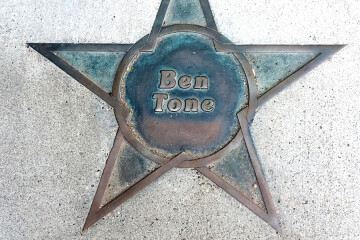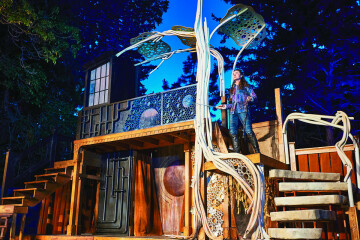Bozeman Actors USO Tour of Asia

The Montana College Players, part of the theatre program at what is today’s MSU, were selected by the USO (United Service Organization) to be part of its 1962 Tour of Asia. This was a special honor and testament to the high-quality theatre in Bozeman; Montana State College was selected from over 80 college and university theatre departments for this entertainment tour of the Pacific Military Command. With stops and performances in Hawaii, Japan, Okinawa, Taiwan, South Korea, and the Philippines, the Players presented over forty performances at Air Force, Army, and Navy bases over seven weeks.
In 1960, Joe Fitch, head of the theatre program at Montana State College, attended an American Education Theatre Conference. The USO had a presence at this conference, hoping to build connections with universities to add to their entertainment offerings for servicemen. As Fitch met with the USO, he convinced them to give his actors an opportunity to present what they could do, inviting them to see his upcoming production, “Prometheus Bound.” The USO officers were very impressed with what they saw and invited the MSC Players to join the USO Asia Tour the following year.
USO had already selected “Three Men On A Horse,” written by John Cecil Holm and George Abbott, to be performed on this tour. This popular 1930s-era farce was about a bookkeeper who could correctly choose the winners in horse races as long as he never placed a bet himself. This sets up the play for the slapstick shenanigans that follow.
Once Fitch knew his Players were accepted for the tour, he cast the play with sixteen actors he had worked with at MSC. Similar to today’s Montana Shakespeare in the Parks tours, everyone in the cast also had a role in the technical aspect of staging the play. Joe Fitch was the director and played “Mr. Carver.” Bruce Jacobson, a Bozeman native, was the tour manager and played “Al.” Ed Hippely became the set designer, production manager, and “Moses.” Marjorie Smith played “Gloria” and was historian/publicist.
The set included several walls, which Hippely designed to be formed by fitting aluminum rods together and covering them with canvas sheets that Marjorie sewed. Everything for the set and costumes had to fit inside thirty-inch lockers for transporting in airplanes and buses.
Once the play and tech crews were in place, rehearsals began. At the same time as rehearsals were taking place, the college designed an academic program for the crew so they could retain active student status during the tour. Their course work was an Asian Studies curriculum over four weeks, enabling the actors to better understand Asian culture.
Shortly before departing on the tour itself, they took the play on a shakedown tour to the Glasgow and Malmstrom Air Force Bases in Great Falls and Glasgow, boarding a Montana National Guard C-47 Skytrain plane at the Bozeman airport. Only two weeks prior to this rehearsal tour, Montana governor Donald Nutter was killed in a plane crash on January 25, 1962, while flying on the very same model of airplane. Hence, the actors were required to wear parachutes during their flights. Several pictures exist of the actors wearing their parachutes while boarding the plane.
The company practiced their packing and loading by flying up to Glasgow and opening their show to an enthusiastic audience of airmen. After Glasgow, bad weather grounded the flight at Malmstrom Air Force Base, so they got to practice traveling by bus to Great Falls, where they performed their final stateside show.
Shortly after returning to Bozeman from Glasgow and Malmstrom Air Force Bases, the Montana State Players left for Hawaii, where they spent their first week performing at the armed services bases there, also exploring the beaches, and simply taking in the sights of this island paradise, which had been granted statehood only two years earlier. It was a tremendous change from Montana, and a taste of the changes they would experience in the days ahead.
Flying on Air Force planes with basic bench seats built into the sidewalls of the aircraft was not Comfort Plus, but it was an exciting and adventurous time, going to places they could only have dreamt about until then. They flew from Hawaii to Japan, where only seventeen years earlier World War II came to an end. Stories of the war in the Pacific were echoing in their heads as they flew westward to the next stop on their USO tour.
Japan had a number of U.S. military bases where the Players set up, performed, packed up, and traveled to the next stop each day for seven days, all across Japan. After an exhausting week of shows, they took a performance break in Kyoto to immerse themselves in the culture and history of this World Heritage City, furthering their Asian Studies course work.
Next was Okinawa, where they met former classmates George and Beverly Mattson after one of their shows. George had graduated from MSC with a degree in Architecture in 1959 and was stationed in Okinawa, serving in the navy. George and Beverly didn’t know the actors very well at that time, so they went backstage after the show to say hello and to “touch home,” connecting with their hometown. The USO was very eager to have publicity photos taken of the performers interacting with service members, so they quickly lined up George and Beverly with some of the performers and took pictures of the Mattsons and the actors to send back to hometown newspapers.
Marjorie Smith remembers the directions they were given by their USO Tour Officer when they landed in Japan and Okinawa: “When you land and start setting up, you will get invitations to meals. If enlisted men ask you to join them, you go eat with them. If the enlisted men don’t ask you, you can go eat with non-coms. If the non-coms don’t ask you, you can go to the Officers Club.” These USO Tour Officers left no doubt in the minds of the Players that their purpose was to perform and interact with the common soldiers, not the officers.
They then went to South Korea, where they traveled to Panmunjom, on the border with North Korea. They were fascinated to see buildings on the U.S. side with corrugated roofs, while on the communist side the buildings had tile roofs. Pigeons were trained to land only on the tiled roofs to “prove” that the communists were the peace lovers.
Gene Beekman, an MSC football player, depicted one of the thugs in the play and had fought in Korea during the 1952-53 war. As the group traveled around South Korea, Beekman remembered where he’d fought, where he’d slept, where he’d marched, and would often point out these places as they were putting up stages and mounting performances. While traveling between venues, Marjorie Smith remembers Beekman reliving those awful moments, calling out; “Right over there — see that trench? That’s exactly the spot I was fighting from during the war.”
Korea made the biggest impression on the Players, in no small part because of the recent war and the scars of war still existing everywhere. They felt like they were doing something positive for the soldiers, bringing them a touch of home for a few hours. The visit to Panmunjom especially impressed the actors with the certainty that there had to be a better way to solve disagreements than bombing people’s homes and fields.
After Korea they traveled to Taiwan, where they performed in Taipei and Tainan. They had an unsettling experience at a performance at Tainan, when the Chinese audience was seated on one side of the auditorium and the Americans were seated on the other side, reflecting the segregation policies still sometimes followed at that time.
Upon their return to Bozeman, George and Beverly Mattson founded the Sweet Pea Festival and became good friends with these actors. They have remained active patrons of the performing arts through the years as George built a successful career as an architect in Bozeman.
Before his tragic death in 1974, Joe Fitch became known as the father of the theatre program at Montana State College. Fitch was instrumental in building the SUB Theatre in 1957, considered the best theatre Bozeman ever had. Fitch also began the Summer Theatre program that performed at the Loft Theatre in the Red Barn (today’s Feed restaurant).
Bruce Jacobson went on to found Montana Shakespeare in the Parks in 1972, and became head of the MSC Theatre Department in 1974.
Marjorie Smith married Carl Smith (another actor on the tour) after the tour ended, and moved away from Bozeman for a few years. After returning, she wrote for the Bozeman Chronicle, published a book, and contributed to Bozeman’s theatre world, performing and directing.
Carl Smith was known as the first theatre major at Montana State College. He twice won the MSC Actor of the Year award. Smith moved to Hawaii, remaining active in theatre and playing roles in the famous TV series, “Hawaii Five-O.”
Marjorie Smith speaks of how life-changing this tour was: “Sitting in a piano bar in Waikiki during our first week of the tour, I was sipping a Tom Collins, listening to jazz and laughing with the others [when] I suddenly knew with great certainty—my life is not going to be at all like my parents’ lives.”
The tour was important to the lonesome-for-home soldiers for whom the group performed. The actors fondly recall the interactions they had with the enlisted men, who eagerly offered their help in setting up the stages and taking down the set, wistfully enjoying every moment of contact they could get with these actors from their home country. The 1962 USO tour to Asia was a complete success for the Players, the soldiers, and for the USO itself.


